Peterbilt
Peterbilt Motors Company is an American-based truck manufacturer. Producing its first truck in 1939, the company specializes in commercial heavy-duty and medium-duty vehicles. Since 1958, Peterbilt has been owned by PACCAR, operating alongside sister division Kenworth Truck Company. Introduced in 1953, a large red-oval brand emblem distinguishes its vehicles.
 | |
| Division | |
| Industry | Truck Manufacturing |
| Founded | 1939 |
| Founder | T. A. Peterman |
| Headquarters | Denton, Texas United States |
| Products | See listing |
| Parent | Paccar |
| Website | www.peterbilt.com |
Founded in Oakland, California, Peterbilt is currently headquartered in Denton, Texas (since 1986); the company manufactures vehicles in Denton, Texas and in Sainte-Thérèse, Quebec (predominantly the class 7 348 models).
History
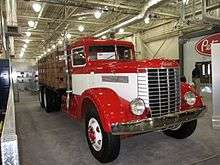
In the first third of the 20th century, logs for the lumber industry were floated downriver, hauled with steam tractors or horse teams. Tacoma, Washington plywood manufacturer and lumberman T.A. Peterman could not get his felled inventory to his lumber mill quickly or efficiently enough to suit his needs, so he looked at the then-nascent automobile technology for logging trucks that could do the job.
Peterman began by rebuilding surplus military trucks, improving the technology with each successive vehicle, such as replacing crank starters with battery powered ones. In 1938, near the end of the Great Depression, he purchased the assets of Fageol of Oakland, California, which had gone into receivership in 1932 (near the depths of the Depression). With the ability to turn out custom built chassis Peterman initially produced two chain-drive logging trucks, which proved unsuccessful. In 1939, he began selling his trucks to the public.
T. A. Peterman died in 1944. His wife, Ida, sold the company to seven individuals within the organization, but retained its land. They then expanded it into a major producer of heavy-duty trucks. In 1958, Ida Peterman announced plans to sell the property to develop a shopping center. The shareholders, not wanting to invest in a new manufacturing facility, sold the company in June 1958 to Pacific Car & Foundry Co., then primarily a manufacturer of railroad freight cars, which had acquired the assets of heavy truck competitor Kenworth in 1944. One year later, Pacific Car and Foundry started construction of a modern 176,000-square-foot (16,400 m2) manufacturing facility in Newark, Calif. In August, 1960 Peterbilt moved to the new facility and became a division of the parent firm. Pacific Car and Foundry Co. changed its name officially to Paccar in 1972.[1]
Models
Current
| Current Peterbilt vehicles | |||
|---|---|---|---|
| Model name | Production | Vehicle type | Notes |
220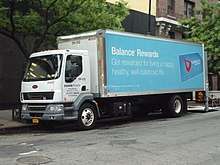 |
1998-2007[2]
2011-present[3] |
medium-duty (Class 7)
COE, low cab forward |
Shares DAF LF cab with Kenworth K370
Built on frame of 330 conventional.[2] |
| 325 | 2007-present | medium-duty (Class 5) | Built for non-CDL applications[4][5] |
| 330
337 348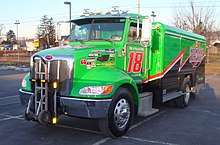 |
2007-present (330)
2009-present (337,348) |
medium-duty
330: Class 6 337: Class 7 348: Class 7/8 |
Introduces single-piece windshield to medium-duty trucks
330: Built for non-CDL applications[6] 337: truck or semitractor[7], replaces 335 348: vocational applications, replaces 340 |
365
367_14.jpg) |
2007-present[8] | severe-service/vocational (Class 8) | 365: 115-inch BBC, replaced 357
367: 123-inch BBC, replaced 378 Both models offered in set-back or set-forward front axle configurations |
389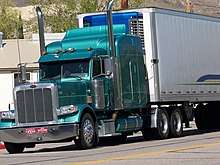 |
2006-present | on-highway (Class 8) | Replaced 379, with redesigned headlamps, fenders, and trim.
131-inch BBC (longest-produced by Peterbilt). Offered in Australia (through 3rd-party conversion to right-hand drive) |
520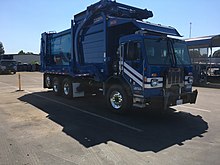 |
2016-present[9] | vocational
COE, low cab forward |
Replaced 320, for refuse collection applications
Redesigned to accommodate PACCAR engines and modernized interior |
| 567 | 2015-present[10] | severe-service/vocational (Class 8) | Shares cab with 579, headlights of 389
115 or 121-inch BBC[10] Offered in set-back or set-forward front axle configurations |
| 579 |
2012-present[11] | on-highway (Class 8) | Replaced 587 as newest Peterbilt "aerodynamic" conventional
123-inch BBC, 83-inch cab width[11] |
Retired (1980 to date)
| Retired Peterbilt vehicles | |||
|---|---|---|---|
| Model name | Production | Vehicle type | Notes |
| Mid-Ranger (200) | 1987-1999[12] | medium-duty (Class 5-7)
COE, low cab forward |
Version of the Volkswagen LT, using MAN G90 (wide-body) cab, produced in Brazil.
Sold with American-market drivetrain |
| 210 | 1998-2007[13]
2011-???[14] |
medium-duty (Class 6)
COE, low cab forward |
Adaptation of DAF LF, shared with Kenworth
Second generation built on 325 frame 26,000-pound GVWR; non-CDL applications[15] |
320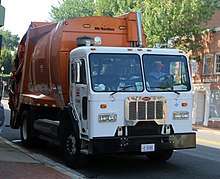 |
1987-2016 | COE, low cab forward | Replaced 310 (and Kenworth Hustler)
Added right-hand stand-up drive to cab[16] |
| 349 | 1980-1987 | on-highway (Class 8) | Light-GVWR highway tractor.[17]
Slightly sloped hood, wider grille than 348; also available with set-back front axle.[18] |
357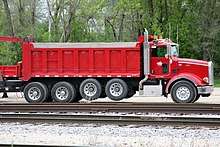 |
1986-??? | on-highway (Class 8) | Severe-service/vocational model line.
Similar in configuration to 378, but with heavier-duty chassis 111-inch through 123-inch BBC; set-back and set-forward front axles Flat-fender hood (similar to 353) offered as an option, along with front PTO[19] |
362.jpg) |
1981-2005 | on-highway (Class 8)
Cabover/COE |
Replaced Model 352 COE; visually similar, all-new design.[20][21]
54-inch to 110-inch BBC; multiple axle configurations (including tandem-steer) 362E (introduced c.1990) with greater interior room, easier entry[21] |
| 372 | 1988-1994 | on-highway (Class 8)
Cabover/COE |
Last all-new Peterbilt COE design
Developed to improve aerodynamics over 362 (sharing its doors and grille[21]); received over 11 MPG in development testing[21][22] Intended for team operation; raised-roof sleeper integrated into large roof fairing; rounded nose fairing raised for engine access. Unusual appearance created many nicknames, including "Winnebago", "football helmet", or "Darth Vader"[21] (or less kind). |
377.jpg) |
1986-2000 | on-highway (Class 8) | First Peterbilt aerodynamic conventional; similar in concept to the Kenworth T600
Fiberglass hood sloped similar to 349, with large fenders (incorporating headlamps and turn signals) 120-inch BBC (set-back front axle), 122-inch BBC (set-forward front axle) Directly replaced by 120-inch 385 (along with 387) |
378.jpg) |
1986-2007 | on-highway (Class 8) | Replaced Model 348
Built for multiple applications, including vocational and on-highway.[23] Similar to 379 (sharing its 119-inch BBC); a higher-mounted cab added a sloped hood design to the model line. Multiple axle configurations; set-forward and set-back front axles |
379 |
1987-2007 | on-highway (Class 8) | Replaced Model 359 as flagship Peterbilt conventional.
119-inch and 127-inch BBC In design change from 359, turn signals moved from fenders to (rectangular) headlamps Replaced by 389 in 2007 |
384_Trucks_Peterbilt_at_Flying_J_Travel_(1).jpg) |
2007-??? | on-highway (Class 8) | 116-inch BBC version of 386[24] |
385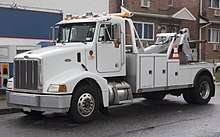 |
1996-2007 | on-highway (Class 8) | Developed to compete with Freightliner FLD 112
Similar in appearance to 377 (different hood slope) 112-inch BBC; set-back front axle standard 120-inch BBC replaced Model 377 |
386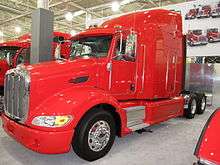 |
2005-2015 | on-highway (Class 8) | Combined aerodynamic hood design of 387 with standard Peterbilt cab design (except external air cleaners)
126-inch BBC |
387.jpg) |
1999-2010 | on-highway (Class 8) | Indirect replacement for Model 377; first Peterbilt aerodynamic conventional with "wide-body" cab
Shares cab structure with Kenworth T2000; built on Peterbilt frame, 387 has different hood, roof fairing, and interior design. Produced as day cab, mid-roof sleeper, and raised-roof sleeper. |
| 388 | 2006-2015 | on-highway (Class 8) | 123-inch BBC configuration of Model 389, replacing 119-inch version of 379
Renamed as 123-inch version of 389 in 2015 |
587_Truck_Peterbilt_at_Flying_J_Travel_Plaza.jpg) |
2010-2016 | on-highway (Class 8) | Replaced 387 as Peterbilt "wide-body" aerodynamic conventional[25] (similar to Kenworth T700)
Redesigned hoodline to improve visibility and lighting. Produced as day cab, mid-roof sleeper, and raised-roof sleeper. |
Historic (before 1980)
Before 1981, model designations started with 2 for single-drive (and tag axle) vehicles, and 3 for dual-drive vehicles. This distinction gradually was phased out in the late 1970s.
| Model name | Production | Vehicle type | Notes |
|---|---|---|---|
| 260
334 |
1939-1941 | Conventional | First Peterbilt model line, evolved from a Fageol design.[26][27]
Logging trucks sold to the public 260: chain drive 334: dual drive axles |
| 270
334 345.jpg) |
1941-1949 | Conventional | On-highway truck
Last model line developed by T.A. Peterman |
| 354
355 364 |
1941-1949 | Conventional | Heavy-duty truck
28 Model 364s produced for the US Navy (1942).[27] |
| 280
350 |
1949-1957 | Conventional
Cabover/COE (1949-1953) |
On-highway truck, nicknamed the "Iron-nose" truck
Butterfly-type hood with cycle-style fenders. Vertical shutters on grille COE version produced, nicknamed "bubble-nose" style (short hood) |
281
351.jpg) |
1954-1976 | Conventional | On-highway truck, nicknamed the "narrow-nose" truck
First model line introduced with red Peterbilt emblem (at launch) Butterfly-type hood with cycle-style fenders. Horizontal shutters on grille Set-back front axle option introduced in 1971 (later becoming 353) |
| 281
351 |
1954-1958 | Cabover/COE | First Peterbilt COE model line developed with its own cab
Shares doors with 281/351 conventional |
| 282
352 352H |
1959-1980 | Cabover/COE | First tilt-cab COE, developed as distinct model line; first UniLite cab
Nicknamed the "Pacemaker" in 1969, coinciding with an update 54-inch to 110-inch BBC 352H is a raised-cab version, fitted with a larger radiator; produced from 1975-1980 |
| 288
358 |
1965-1976 | Conventional | Variant of 281/351 with a tilting hood, first Peterbilt equipped with a design.[28][29]Fiberglass hood introduced in 1972.[30]
First Peterbilt model line with current hood ornament design |
289
359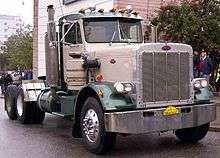 |
1967-1987 | Conventional | Replaced 281/351
Distinguished by wider grille for larger radiator Replaced by 379 |
| CB300 | c.1975-1978 | COE, low cab forward | First Peterbilt truck designed for refuse applications
Designed and produced jointly between Peterbilt and Kenworth[31] |
| 310 | 1978-1986 | COE, low cab forward | Replaced CB300, designed for refuse applications
Model 319 used rear PTO and rear lift axle with steering capability[31] |
| 351L | Conventional | Severe-service variant of 351 designed specifically for logging[30]
Flat diamond-plate fenders | |
| 341 | 1954-1972[30] | Conventional | Short-hood variant of the 351 designed for vocational applications
Replaced by 348 |
| 346 | 1972-1975 | Conventional (Class 9) | Designed for vocational applications, with a (highly) set-back front axle
Only 10 produced, second-rarest model line |
| 348 | 1970-1986 | Conventional | Designed for cement mixers and dump trucks
First Peterbilt with a sloped fiberglass hood |
| 353 | 1973-1987 | Conventional | Designed for construction applications, flat steel fenders
Used grille of 359 (radiator) with butterfly hood Replaced 341 and 351 vocational trucks |
| 381 | c.1975 | Conventional | Severe-service truck, 6x6 drive configuration[30]
Flat fenders, butterfly hood; lower, narrower radiator than 383 |
| 383 | c. 1966-1979 | Conventional | Severe-service truck, 6x6 drive configuration[30]
Flat fenders extend to back of cab |
| 387 | 1976-1987 | Conventional (Class 9) | Severe-service truck, originally developed for coal transportation
Later developed for multiple applications Model number reused in 1999 (only model line to do so) |
| 391 | c.1977 | Conventional (Class 9) | Logging truck, similar in design to the 387; only one built
Built using a Kenworth frame and a Peterbilt body, current whereabouts unknown |
397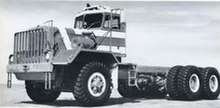 |
Conventional (Class 9) | Largest Peterbilt model line, 2 examples built
up to 500,000-pound weight capacity, with up to 600 hp engines[32] |
Sleepers
In the 1960s and 1970s, 30" and 36" sleepers were available. If a buyer wanted a larger sleeper, Peterbilt worked with Mercury Sleepers for 40", 60", and custom sized sleepers. Mercury would paint the sleeper to match the factory paint or the sleeper came with polished quilted aluminum. In 1978, Peterbilt's engineers were tasked with making a bigger sleeper. They designed the 63" sleeper with rounded doors and a walk-through from the cab. The sleeper debuted on a 359-127" and can be seen in the 1978 brochure "Best in Class". This truck also featured the first set of rectangular headlamps. The first raised roof (high cube) sleeper was on a 359 in 1986 and with changes (no right hand forward door) carried through to the 379 family. In 1994, the Unibilt sleeper debuted with air-ride suspension for the cab and sleeper with a large cab to sleeper opening. The Unibilt sleeper suspension had a one piece shock/air bag mount system from 1994 to 2006, until Peterbilt redesigned the suspension system for the 2007 model year, making the shock and air bag system on separate brackets. The Unibilt cab/sleeper option allowed for the sleeper to be removed for a daycab conversion. The UltraSleeper was Peterbilt's largest and most luxurious. At 70" long, it featured a right-hand access door, table, closet and a small "wet closet" accessible from the driver's side to store boots, gloves, and other 'damp' items. The last UltraSleeper was built in 2005 [33]
Facilities
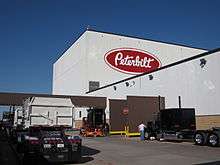
From 1939 until the mid-1980s, the company was based in the East Bay area of Northern California. The original plant was in Oakland, which closed in 1960 and moved to nearby Newark. Truck production moved to Denton, Texas at the close of 1986, but division headquarters and engineering remained in California until 1992, when a new administrative complex and engineering department at the Denton plant was completed. The Madison/Nashville plant opened in 1969 in Madison, Tennessee, for the east coast market. Originally it only manufactured the 352/282 cabover, then conventional production began in the 1970s until it was closed in 2009. Production of Class 8 trucks continues at the Denton, Texas plant (www.peterbilt.com).
References
- History Paccar
- Nunlist, Tom; Editor, Associate. "Peterbilt 210 and 220 Low COE to Return Next Year". www.truckinginfo.com. Retrieved 2019-11-18.CS1 maint: extra text: authors list (link)
- Staff. "Peterbilt Enhances Medium-duty Models 210, 220". www.truckinginfo.com. Retrieved 2019-11-18.
- "Model 325 | Peterbilt". www.peterbilt.com. Retrieved 2019-11-18.
- www.ccjdigital.com https://www.ccjdigital.com/peterbilt-introduces-model-325-for-class-5-market-2/. Retrieved 2019-11-18. Missing or empty
|title=(help) - "Model 330 | Peterbilt". www.peterbilt.com. Retrieved 2019-11-18.
- "Model 337 | Peterbilt". www.peterbilt.com. Retrieved 2019-11-18.
- www.topspeed.com https://www.topspeed.com/trucks/truck-reviews/peterbilt/2007-peterbilt-365-ar127373.html. Retrieved 2019-11-18. Missing or empty
|title=(help) - Staff. "Peterbilt Unveils Model 520 for Refuse Fleets". www.truckinginfo.com. Retrieved 2019-11-18.
- Staff. "Peterbilt Showcases Model 567". www.truckinginfo.com. Retrieved 2019-11-18.
- Staff, Truckinginfo. "Peterbilt Introduces 'New From the Ground Up' Model 579". www.truckinginfo.com. Retrieved 2019-11-18.
- "From LT to Worker - Volkswagen's Versatile, Long-lasting "LT" Cab". BigMackTrucks.com. Retrieved 2019-11-18.
- Nunlist, Tom; Editor, Associate. "Peterbilt 210 and 220 Low COE to Return Next Year". www.truckinginfo.com. Retrieved 2019-11-18.CS1 maint: extra text: authors list (link)
- Staff. "Peterbilt Enhances Medium-duty Models 210, 220". www.truckinginfo.com. Retrieved 2019-11-18.
- [peterbilt.com "Peterbilt"] Check
|url=value (help). Peterbilt. - Sandhills Publishing Company. "Peterbilt History | Peterbilt of Louisiana | New and used Peterbilt truck dealer". www.peteoflouisiana.com. Retrieved 2019-11-21.
- "Peterbilt Spotters Guide - Pre 1980 Conventionals". www.timstrucks.com. Retrieved 2019-11-19.
- "Tims Trucks PB2". www.timstrucks.com. Retrieved 2019-11-20.
- "Peterbilt Expands Its 357 Vocational Series". Construction Equipment. Retrieved 2019-11-22.
- says, Yusef Transit (2019-06-17). "The History of Peterbilt Trucks". Allstate Peterbilt Group. Retrieved 2019-11-18.
- "Tims Trucks PB9". www.timstrucks.com. Retrieved 2019-11-20.
- "Peterbilt". Peterbilt.
- "Peterbilt". peterbilt.com. Retrieved 3/8/19. Check date values in:
|accessdate=(help) - "Peterbilt Spotters Guide - 386 and 384". www.timstrucks.com. Retrieved 2019-11-21.
- www.overdriveonline.com https://www.overdriveonline.com/peterbilt-launches-model-587/. Retrieved 2019-11-21. Missing or empty
|title=(help) - "Heritage | Peterbilt". www.peterbilt.com. Retrieved 2019-11-18.
- says, Yusef Transit (2019-06-17). "The History of Peterbilt Trucks". Allstate Peterbilt Group. Retrieved 2019-11-18.
- [peterbilt.com "Peterbilt Website"] Check
|url=value (help). Peterbilt. Retrieved 3/6/19. Check date values in:|accessdate=(help) - [peterbilt.com "Peterbilt"] Check
|url=value (help). - "Peterbilt Spotters Guide - Pre 1980 Conventionals". www.timstrucks.com. Retrieved 2019-11-19.
- Sandhills Publishing Company. "Peterbilt History | Peterbilt of Louisiana | New and used Peterbilt truck dealer". www.peteoflouisiana.com. Retrieved 2019-11-21.
- http://timstrucks.site.aplus.net/397brchr.jpg. Missing or empty
|title=(help) - "Peterbilt.com". Peterbilt.com. Retrieved 5 March 2019.
